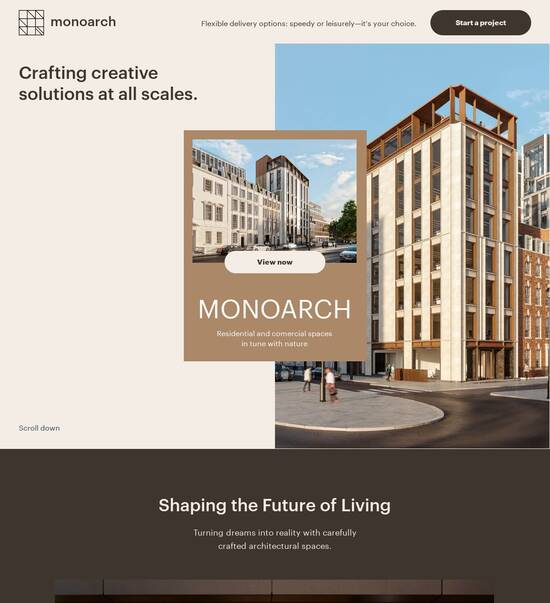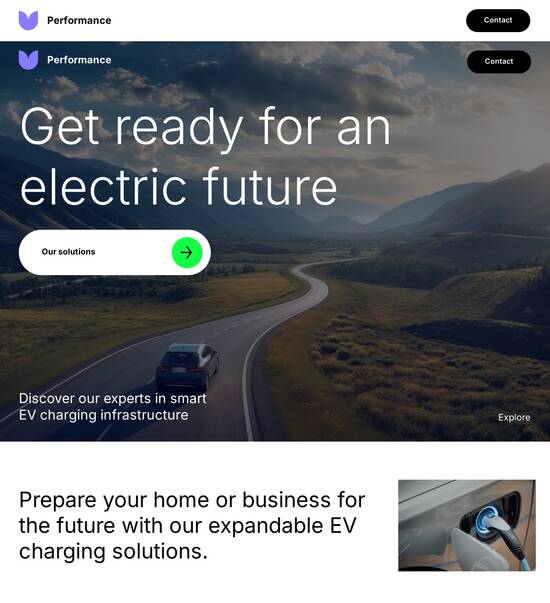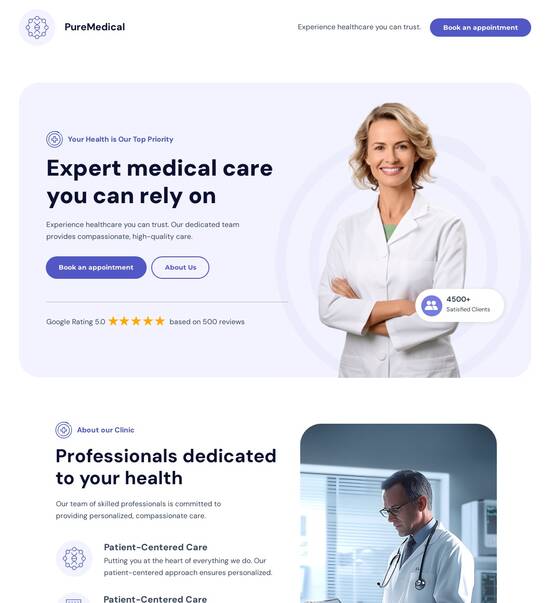
HTML page template for e-commerce platforms
Use TemplateAbout template
Engage your audience like never before with stunning landing page templates for e-commerce platforms. Make your online presence unforgettable!
Recommended templates

Easy to build without coding
With the intuitive drag-and-drop builder, anyone on your team can create high-converting pages without any knowledge of code or design. Make enhancements to your landing page with custom widgets using Javascript, HTML/CSS, or third-party scripts.

Multiple layouts for any industry and goal
Select from 500+ landing page layouts built to boost conversions across industry-specific scenarios. Customize them by adjusting fonts, adding images, and generating on-brand content with the AI assistant. Quickly scale with Instablocks® and Global Blocks that you can save, reuse, and update globally.

Loads fast and looks polished on any device
Every template is responsive, which means they present professionally on any device and load blazingly fast with our Thor Render Engine. You can also power them up with Google AMP technology to deliver an unparalleled mobile experience and drive higher conversions.

Robust analytics & experimentation
Get real-time updates and reporting across all your devices, showing the number of visitors, conversions, cost-per-visitor, and cost-per-lead. Launch AI-powered experiments, run A/B tests, and use heatmaps to analyze user behavior, then optimize your landing page to maximize conversions.







Easy to build without coding
With the intuitive drag-and-drop builder, anyone on your team can create high-converting pages without any knowledge of code or design. Make enhancements to your landing page with custom widgets using Javascript, HTML/CSS, or third-party scripts.
Multiple layouts for any industry and goal
Select from 500+ landing page layouts built to boost conversions across industry-specific scenarios. Customize them by adjusting fonts, adding images, and generating on-brand content with the AI assistant. Quickly scale with Instablocks® and Global Blocks that you can save, reuse, and update globally.
Loads fast and looks polished on any device
Every template is responsive, which means they present professionally on any device and load blazingly fast with our Thor Render Engine.
Robust analytics & experimentation
Get real-time updates and reporting across all your devices, showing the number of visitors, conversions, cost-per-visitor, and cost-per-lead. Launch AI-powered experiments, run A/B tests, and use heatmaps to analyze user behavior, then optimize your landing page to maximize conversions.
All the features you need to build lead-generating landing pages
Explore more featuresLearn how to build top-performing landing pages for any goal
FAQs
Leading the way in building high-performing landing pages





A step-by-step guide to creating landing pages with Instapage
Crafting high-converting landing pages is crucial for marketers aiming to maximize ROI. Instapage provides the most robust landing page and conversion rate optimization (CRO) platform, supporting businesses across diverse sectors like tech, education, and financial services. This step-by-step guide will walk you through leveraging Instapage to enhance your digital marketing campaigns effectively.
Understanding the power of Instapage
Instapage is designed to empower marketers with a seamless experience in creating landing pages. Its expansive library of 100+ customizable templates and pre-built lead generation elements helps streamline the page creation process. Whether you’re an individual or part of a large team, Instapage adapts to your specific needs.
- Enhanced User Experience: Instapage's intuitive interface allows for quick page launches without coding, ideal for marketers looking to save time.
- High Conversion Rates: Templates are built based on proven best practices, ensuring users engage with high-quality designs.
- Collaboration Tools: Enable real-time editing and feedback, facilitating team collaboration seamlessly.
Step 1: Select the right template
Choosing the right template is pivotal in attracting visitors. Start by browsing through Instapage’s rich template library, designed for various industries. Each template is optimized for conversion, making it easier to personalize your messaging.
- Template filters: Use filters to find templates tailored for your industry.
- Preview options: View templates in real-time to understand how they will appear to your audience.
- Customization features: Take advantage of built-in tools that allow you to modify colors, images, and layout without any technical skills.
Step 2: Optimize your pages
An optimized landing page increases the likelihood of conversions. Leverage Instapage's built-in experimentation features to conduct A/B tests for different versions of your landing pages.
- Heatmaps: Utilize heatmaps to analyze where users interact the most on your page.
- A/B Testing: Test different headlines, CTAs, and images to determine what resonates best with your audience.
- Analytics Dashboard: Track conversion rates and engagement metrics to refine future campaigns.
Step 3: Personalize your campaigns
Personalization can significantly enhance user engagement. Use Instapage's dynamic text replacement capabilities to customize messages based on visitor data, ensuring a tailored experience for every user.
- AdMaps: Align specific ads with dedicated landing pages to target unique audiences effectively.
- Audience analytics: Analyze user behavior and preferences to adjust messaging and offers appropriately.
- Tailored content: Create content that speaks directly to the needs and pain points of different audience segments.
Using these strategies with Instapage ensures your landing pages are not only well-designed but also equipped to convert leads into customers.
Ready to supercharge your marketing efforts? Get started with Instapage today and experience the benefits of an all-in-one landing page and CRO platform.
People also ask about HTML page template for e-commerce platforms
HTML page template for e-commerce platforms: A comprehensive overview
The crucial role of HTML page templates in e-commerce success
HTML page templates are pre-designed layouts used for creating web pages specifically tailored to e-commerce needs. They encapsulate the essential elements and structures required for successful online retail without the need for extensive coding. The importance of these templates cannot be overstated; they serve as the backbone for online shops, influencing both their visual appeal and functionality. A well-crafted HTML page template can streamline the design process, allowing businesses to focus on products and marketing instead of starting from scratch.
Customization and flexibility are vital characteristics of HTML page templates, giving e-commerce platforms the ability to adapt to their brand's unique style and functionality requirements. By allowing for extensive modifications, these templates can easily cater to diverse market segments, helping businesses to stand out in an ever-competitive environment. Furthermore, well-designed templates significantly enhance user experience, facilitating easier navigation, quicker purchases, and ultimately fostering customer loyalty, which is critical for long-term success.
Types of e-commerce HTML page templates
Understanding the different types of HTML page templates available for e-commerce is essential as each serves distinct purposes. Common types include product showcase templates, checkout page templates, landing page templates for promotions, and blog and content page templates. Each template type is strategically designed to optimize specific user interactions, thus enhancing overall efficiency and performance.
Product showcase templates: These templates focus on highlighting products. Features such as high-quality images, customizable descriptions, and user review sections can significantly increase product visibility and desirability.
Checkout page templates: A critical phase in the purchasing journey, these templates include elements like progress indicators and autofill options to reduce abandonment rates while ensuring secure payment options are evident to maintain user trust.
Landing page templates for promotions: Used for showcasing seasonal discounts, these templates help integrate with marketing campaigns effectively, providing strategic navigation paths.
Blog and content page templates: These are vital for building brand authority through valuable content, enhancing SEO performance, and providing users with helpful information related to products.
Key features of effective e-commerce HTML page templates
An effective e-commerce HTML page template incorporates several key features that contribute to its overall success. Firstly, responsive design is non-negotiable; with mobile shopping on the rise, templates must function flawlessly across various devices. Consequently, utilizing techniques such as fluid grids and flexible images can enhance mobile compatibility and improve the overall experience for users.
Speed optimization is equally important. Fast load times correlate directly with improved conversion rates, as slow-loading pages can lead to user frustration and abandonment. Tools like Google PageSpeed Insights can help developers measure performance and identify areas for improvement. In addition to speed, customizability through CSS and JavaScript allows businesses to tailor designs to their specific brand identity, ensuring the unique character of the business is carried through in digital presence.
SEO-friendly structures: Templates should integrate best practices for on-page SEO, including meta tags, structured data, and semantic HTML to enhance visibility within search engines.
Built-in experimentation features: This enables marketers to optimize landing pages continuously through A/B testing and performance analytics.
The development process of e-commerce HTML page templates
The development process of e-commerce HTML page templates is typically a collaborative effort between designers and software engineers, wherein both aesthetic attributes and functional capabilities must be harmonized. Effective integration of visual appeal and usability is crucial. Employing methodologies like Agile promotes enhanced communication and iterative feedback among team members, leading to the production of high-quality templates.
Considering both frontend and backend aspects is critical in creating a seamless user experience. Frontend developers focus on the elements that users interact with directly, while backend developers ensure the proper functioning of databases and server requests. Utilizing frameworks like Bootstrap or Foundation can accelerate the development process, providing developers with a robust foundation of pre-built components, which in turn, facilitates faster cycles and more efficient template creation.
Exploring themes: Customization beyond the basics
Themes play a pivotal role in e-commerce HTML page templates by influencing user engagement and brand perception. Psychological factors often dictate theme selection; colors, layout, and imagery can elicit specific emotional responses from visitors. Successful brands often invest in carefully designed themes that align with their target audience's preferences and motivations, as evidenced by various case studies demonstrating the direct correlation between theme aesthetics and user behavior.
Moreover, marketers have the option to choose between pre-built themes and custom themes. While pre-built themes may be cost-effective, they might not provide all the features businesses need. On the other hand, custom themes often come with a higher price tag and longer development times but can cater precisely to specific requirements and desired functionalities. Additionally, plugins and extensions can enhance both types of themes, offering additional features that can address specific business needs.
Addressing common challenges in e-commerce HTML template development
While creating e-commerce HTML templates, developers face several common challenges, including spam and security issues. Protecting user data is a priority, and employing strategies like CAPTCHA can help deter spam actions in forms while educating customers about security best practices ensures trust is maintained throughout the shopping process. Establishing robust security protocols is essential in safeguarding user information.
Maintaining consistency across templates and pages also poses a challenge. Utilizing design systems and style guides can streamline designs, ensuring brand identity remains coherent across various templates. Moreover, addressing browser compatibility is crucial; developers should employ best practices for cross-browser testing, utilizing tools like BrowserStack to ensure functionality across different platforms. Fallback strategies must also be implemented for outdated browser versions, ensuring a wide-reaching audience can access the e-commerce site without issue.
Innovative trends in e-commerce HTML page templates
Innovation never ceases in the realm of e-commerce HTML page templates. One notable trend is the adoption of dynamic content adaptation, wherein templates evolve based on user interactions. This forward-thinking approach employs AI-driven personalization, leading to unique experiences for individual users. Brands successfully leveraging such dynamic elements have reported greater engagement and conversion rates, demonstrating the power of personalization in enhancing customer journeys.
Integration with e-commerce platforms is another area of significance. Modern templates support API functionalities for popular platforms, facilitating seamless plugin integration for payment gateways or marketing tools. Furthermore, sustainability and ethical considerations are gaining traction. Businesses focusing on eco-friendly design choices are encouraging conscious consumerism, showcasing sustainability as a core value. As customers become more environmentally aware, aligning design choices with ethical principles can draw in loyal consumers.
The role of user feedback in template improvement
User feedback is an invaluable component in refining HTML page templates for e-commerce. By collecting and analyzing data, businesses can gain insights into how users interact with their templates, allowing for informed decision-making based on actual customer behavior. A/B testing is particularly beneficial, enabling marketers to test variations of templates and identify which elements contribute most to conversions and user satisfaction.
Incorporating user suggestions effectively can lead to iterative design improvements, prioritizing user experience in template development. Building a user-focused culture encourages ongoing adjustments based on customer input, ensuring that the evolving needs and expectations of the target audience are consistently met.
Real-life examples: Brands excelling with distinctive templates
Exploring real-life examples of brands excelling with well-designed HTML page templates can provide insights into their successful strategies. For instance, one case study reveals a brand that transformed its user experience by revamping its templates. This involved optimizing images, simplifying navigation, and incorporating user feedback, resulting in a substantial increase in engagement metrics and ultimately, sales.
Another noteworthy case study involves a brand that leveraged unique features within its templates to drive sales. Features such as chatbots for customer support and gamified discounts engaged users effectively, demonstrating that innovation, when combined with user-centric design, can lead to remarkable results. This brand's journey underscores the importance of continuous evaluation and adapting templates to meet evolving consumer needs.
Future projections for HTML page templates in e-commerce
As technology advances, the landscape of e-commerce HTML page templates continually evolves. Emerging technologies, such as Web Assembly and Progressive Web Apps (PWAs), are set to enhance user interactions and speed, allowing for faster, more efficient web applications. Additionally, the incorporation of virtual reality (VR) and augmented reality (AR) has the potential to revolutionize e-commerce, providing immersive shopping experiences that can influence the design and functionality of future templates.
With shifts in consumer behavior also on the horizon, businesses must adapt their templates to meet changing expectations. The emphasis on user experience and personalization is expected to increase, prompting more intricate, interactive elements within e-commerce designs. Anticipating these trends will allow businesses to remain competitive and ensure their templates meet the demands of next-generation consumers.
Ready to skyrocket conversions?
Supercharge your ad campaigns with high-performing landing pages
Get started














